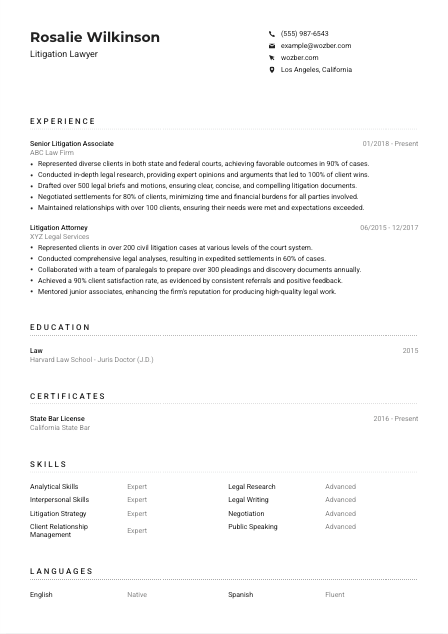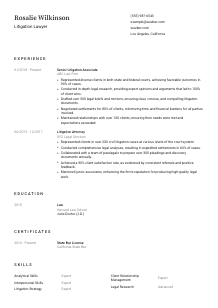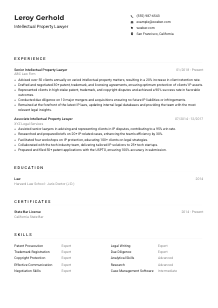Litigation Lawyer Resume Example
Fighting legal battles, but your resume feels like it's stuck in litigation limbo? Present your case with this Litigation Lawyer resume example, argued into shape using Wozber free resume builder. Learn how to channel your courtroom victories to satisfy job criteria, making your legal career a resounding success story, not a mistrial!

How to write a Litigation Lawyer Resume?
Embarking on your journey to stand out in the crowd as a Litigation Lawyer? Your resume is your first line of defense and your best advocate in the competitive legal landscape. Crafting an ATS-compliant resume that aligns with the job you're eyeing isn't just optional; it's essential.
With the help of our free resume builder and a deep dive into the art of resume creation tailored for Litigation Lawyers, we're here to guide you through molding your qualifications, experience, and skills into a compelling and ATS-friendly resume format. Let the verdict be in your favor!
Personal Details
This section is your opening argument. It sets the tone for your whole resume, showcasing your professionalism and preparedness. Experience has taught us that details matter, so let's approach this with the precision of preparing for a day in court.
1. Name with Authority
Your name is your brand in the legal world, make it memorable. Use a bold, professional font that stands out but remains classic, much like a strong opening statement in court.
2. Job Title Precision
Directly under your name, position the job title you're aiming for. In this case, "Litigation Lawyer" mirrors the sought role, immediately aligning your resume with the job at hand.
3. Critical Contact Details
- Phone Number: Ensuring this is correct is like double-checking case files before a trial. Leave no room for error.
- Professional Email Address: Keep it simple and professional. A format with your first and last name at a reputable email provider establishes credibility.
4. Address: Your Strategic Location
The job's geography plays a vital role in the selection process. Mentioning "Los Angeles, California" underscores your alignment with the role's logistical requirements, showcasing readiness and eliminating any concerns about relocation.
5. Digital Presence
In today's legal world, being digitally savvy is a plus. Include a LinkedIn profile to provide depth to your resume, ensuring it's polished and mirrors your resume's narrative.
Takeaway
Your Personal Details section is not an afterthought; it's a deliberate, strategic element of your resume. Craft it with the same care you would prepare your case briefs. Make every detail count.





Experience
This section is the heart of your case, where you prove your worth beyond a reasonable doubt. Your track record of success, represented by well-documented accomplishments, speaks volumes to hiring managers in the legal domain.
- Represented diverse clients in both state and federal courts, achieving favorable outcomes in 90% of cases.
- Conducted in‑depth legal research, providing expert opinions and arguments that led to 100% of client wins.
- Drafted over 500 legal briefs and motions, ensuring clear, concise, and compelling litigation documents.
- Negotiated settlements for 80% of clients, minimizing time and financial burdens for all parties involved.
- Maintained relationships with over 100 clients, ensuring their needs were met and expectations exceeded.
- Represented clients in over 200 civil litigation cases at various levels of the court system.
- Conducted comprehensive legal analyses, resulting in expedited settlements in 60% of cases.
- Collaborated with a team of paralegals to prepare over 300 pleadings and discovery documents annually.
- Achieved a 90% client satisfaction rate, as evidenced by consistent referrals and positive feedback.
- Mentored junior associates, enhancing the firm's reputation for producing high‑quality legal work.
1. Analyze the Job Requirements
Break down the Litigation Lawyer job description to understand the specific experiences sought. Look for keywords like 'conduct legal research,' 'represent clients in court,' and 'negotiate settlements.'
2. Chronological Order
Order your roles from most recent to oldest. Each entry should clearly state the role title, the name of the firm, and the dates of your tenure. This orderly presentation mirrors a well-structured argument, leaving no room for confusion.
3. Action-Oriented Accomplishments
For each role, craft bullet points that begin with action verbs. Highlight successful outcomes, such as cases won or successful negotiations, and quantify these achievements to give them weight, akin to presenting evidence in court.
4. Relevancy is Key
Concentrate on experience that aligns with the job requirements. While being the social committee chair is notable, focus on your litigation successes and responsibilities tied to the job at hand.
5. Continuous Learning and Leadership
Showcase how you've advanced in your field, maintained client relationships, and mentored junior associates. This demonstrates your commitment to both personal growth and the firm's success.
Takeaway
In crafting your Experience section, think of yourself as arguing a case. Each role and accomplishment you list is proof of your expertise and capability. Make it compelling, make it clear, and above all, make it speak to your strengths as a Litigation Lawyer.
Education
In the realm of law, your academic credentials lay the foundation of your expertise. Highlighting your educational background is akin to laying out the legal framework before delving into the specifics of a case.
1. The Cornerstone of Your Career
Begin with your highest degree relevant to the job – in this case, the Juris Doctor (J.D.) degree. This anchors your educational qualifications to the role, underscoring your legal acumen.
2. Clarity and Brevity
List your degree, the school you attended, and the graduation date. This clear, straightforward format respects the hiring manager's time by making the information easy to digest, like an organized legal document.
3. Beyond the Degree
While the J.D. is crucial, also include your undergraduate degree if it adds to your profile's depth, such as a Bachelor of Arts in Political Science. This showcases a broadened perspective beneficial in complex litigation scenarios.
4. Relevant Courses and Achievements
If you have room, consider adding relevant law courses or achievements such as moot court participation or law review involvement. These details build a picture of a committed and engaged law student.
5. Continuing Education
If applicable, include any additional certifications or continuing education courses that demonstrate your commitment to keeping your legal knowledge up-to-date. This signals a dedication to excellence and lifelong learning.
Takeaway
Your Education section is a testament to the rigorous path you've traversed to reach this point. It sets the stage for your professional accomplishments, providing a solid backstory to your expertise. Detail it with precision and pride.
Certificates
Certificates showcase your additional legal skills and your dedication to professional development. This is your chance to highlight your specialized training that makes you stand out in a pile of litigation lawyer resumés.
1. Review and Reflect
Identify certificates that directly relate to the job requirements. For instance, holding a California State Bar License is a non-negotiable for a Litigation Lawyer in Los Angeles.
2. Cherry-Pick Your Certifications
While you may have several certifications, prioritize those most relevant to litigation, such as a Certified Litigation Management Professional (CLMP). This shows commitment to your field beyond the basic qualifications.
3. Keep Dates in Mind
If the certification has an expiration date or if it's particularly recent, listing the date can underscore your current expertise and dedication to staying updated in your practice.
4. Continuous Improvement
The legal landscape is always evolving, as should your certifications. Regularly updating your knowledge base through certifications not only benefits your practice but also demonstrates a proactive attitude to potential employers.
Takeaway
Certificates can be the differentiator in your resume, showcasing a commitment to excellence and a versatile skill set. Select and present them thoughtfully to amplify your qualifications and stand out as the best candidate for the role.
Skills
In a profession where precision, analysis, and persuasive communication are paramount, your Skills section is your opportunity to showcase your legal arsenal. This is where you highlight the tools at your disposal that make you an outstanding Litigation Lawyer.
1. Extract From Job Description
Start with a thorough analysis of the job posting. Identify both the explicit and implied skills required. Skills like 'strong interpersonal skills' and 'exceptional research and analytical abilities' are often highlighted.
2. Direct Alignment
Focus on listing skills that match the job description. This not only shows that you're a fit but also helps get past the ATS filters. ATS optimization is crucial, and aligning your skills with job requirements is a key step.
3. Organize and Prioritize
Your skills should be easily digestible at a glance. Organize them in a way that the most relevant and impactful skills are immediately noticeable, making it evident why you're the top contender for the role.
Takeaway
Your skill set is the backbone of your capability as a Litigation Lawyer. Carefully tailoring this section to match job requirements not only satisfies ATS algorithms but also showcases your professional arsenal to potential employers. Ensure it's sharp, relevant, and undeniably yours.
Languages
In the diverse and often multicultural landscape of Los Angeles law, linguistic prowess can set you apart. This section allows you to showcase your ability to navigate complex legal dialogues across different languages.
1. Match Job Specification
While the job description emphasized the necessity of clear expression in English, the advantage of being bilingual, especially in Los Angeles, cannot be understated.
2. Emphasize Proficiencies
Start by listing the languages required for the job, marking your proficiency level. Being 'Fluent' in Spanish, for instance, can significantly augment your appeal in a bilingual city.
3. Showcase Additional Languages
Even if not specified, additional languages you speak can be a massive asset, particularly in international litigation or cases involving non-English speakers. It showcases cultural competence and adaptability.
4. Honesty in Proficiency
Be truthful about your language levels. Overstating your fluency could lead to uncomfortable situations, much like being unprepared for a cross-examination.
5. Recognize the Role's Dynamics
Understanding the dynamics of the role you're applying for can help you decide which languages to highlight. In a city as culturally rich as Los Angeles, the more languages you speak, the broader your client base can become.
Takeaway
Languages are not just a form of communication; they're an avenue to understanding diverse perspectives and narratives, crucial in the field of law. Highlighting your linguistic capabilities could well be the clincher in landing your role as a Litigation Lawyer.
Summary
Your summary is your opening statement on paper, the trailer to the feature film that is your career. This is your opportunity to captivate the hiring manager, prompting them to delve deeper into your resume.
1. Reflect on the Role
Before crafting your summary, get intimately familiar with the job description. Reflect on how your experiences and skills align with the role of a Litigation Lawyer.
2. Craft an Engaging Introduction
Start with a strong opening that encapsulates your professional identity. Mention your years of experience and a standout accomplishment, such as your success rate in court.
3. Highlight Key Expertise
Proceed to succinctly list key skills and achievements that are directly relevant to the job. This is where you underscore your proficiency in areas like legal research, client relationship management, and litigation strategy.
4. Make it Concise
Keep your summary tight and impactful. Aim for 3-5 lines that encapsulate who you are as a professional, leaving no doubt about your fit for the role.
Takeaway
A well-crafted summary doesn't just echo your qualifications; it amplifies them. It convinces the hiring manager that you're not just another application but a standout candidate who deserves a closer look. Treat it as your chance to make a lasting impression.
Launching Your Litigation Lawyer Journey
You now have the blueprint to craft a compelling ATS-compliant resume that speaks directly to the needs of hiring managers looking for a Litigation Lawyer. Each section of your resume should work in concert, creating a narrative of expertise, dedication, and success. Use our free resume builder to align your resume with your career goals efficiently and effectively. The courtroom awaits your prowess; let your resume open the doors. Here's to your success!

- Juris Doctor (J.D.) from an accredited law school and licensed to practice law in the relevant jurisdiction.
- Minimum of 5 years of experience in civil litigation, with a strong track record of success representing clients in court.
- In-depth knowledge of federal, state, and local laws, regulations, and procedures pertaining to litigation.
- Exceptional research, analytical, and writing skills, with the ability to present complex legal issues concisely.
- Strong interpersonal skills and the ability to work collaboratively with clients, colleagues, and opposing counsel.
- Ability to express oneself clearly in English is required.
- Must be located in Los Angeles, California.
- Represent clients in state and federal courts, at both the trial and appellate levels.
- Conduct legal research to provide expert opinions and arguments to clients and the court.
- Prepare legal briefs, motions, pleadings, and other litigation-related documents.
- Negotiate settlements on behalf of clients, minimizing time and financial burden.
- Maintain strong relationships with current and potential clients, ensuring their needs are met and expectations exceeded.















